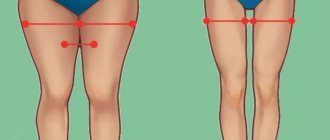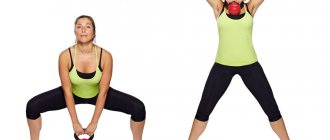The question of rest time between approaches is one of the most controversial. The answers to it sometimes diverge by 180 degrees, and even professionals can easily name completely different numbers - from 30 seconds to 2-3 minutes. Oddly enough, any of these answers may be correct, because the time to rest between sets depends on the specifics of the workout and your well-being. You need to choose it purely intuitively , so you won’t see exact numbers here. Instead, we'll talk about 9 principles that will help you determine how much rest you need between sets at any given point in your workout.
The more weight, the more rest.
To know how much rest you need between approaches, you need to focus on your working weight. In the previous example, we talked about possible hypothetical intervals for a weightlifter performing a 3x3 set with a 165 kg barbell. If your working weight is 224 kg, your optimal intervals should be even longer, perhaps 6 to 8 minutes or even more.
This recommendation leads to one simple conclusion. Multi-joint exercises, where you lift more weight, require longer pauses between sets than isolation exercises. So the rest time between deadlifts and dumbbell curls will be completely different.
Rest between sets
Oddly enough, the topic of rest between approaches, despite its importance, is considered very superficially, and often downright illiterately, in the existing methodological literature on strength sports. Specific time intervals are proposed - 1-2-3-5-10 minutes, sometimes correct from the point of view of modern science, sometimes false, but I have almost never seen a physiological explanation why rest of this particular duration is necessary for training in a certain direction.
Let's try to analyze this issue in detail. To repeat the next set to failure with the same working weight as in the previous approach, we need to restore the reserves of ATP and creatine phosphate in the muscle and remove acid from it. Modern research shows that 90% of KrF reserves are restored within one minute. That is, if you have to work at maximum power, using almost all motor units, these reserves are enough to complete a full approach.
Acidification is a little more complicated. If CrP (creatine phosphate) begins to be resynthesized immediately after the end of the approach, then the amount of acid continues to increase during the first three to four minutes of rest, primarily due to the resynthesis of CrP, which provides anaerobic glycolysis of GMF (glycolytic muscle fibers) and aerobic glycolysis OMF (oxidative muscle fibers) and PMF (intermediate muscle fibers). Aerobic glycolysis is harmless for us, since it does not produce lactic acid, but anaerobic glycolysis creates problems. One hundred percent replenishment of creatine phosphate reserves occurs in just three to four minutes, so all this time new hydrogen ions will continue to be formed.
When training aimed at hypertrophy of the muscle mass, we work in static dynamics, that is, without muscle relaxation while performing the approach for 30-40 seconds. Rest between sets – 30 seconds. Such a short rest is only permissible for OMV training. This is done specifically to increase the length of time free creatine remains inside the muscle fibers, thereby increasing the effectiveness of the exercise. Let me remind you that there are four main factors that determine accelerated protein synthesis in a cell: an increased content of amino acids in the cell; increased concentration of anabolic hormones in the blood (may be as a result of mental stress and physiological stress, or maybe as a result of taking anabolic steroids); increased acid concentration (naturally, not exceeding a certain limit at which the processes of catabolism begin to dominate over anabolism); increased concentration of free creatine in CF. Not to be confused with KrF! Free creatine is Creatine, which has already donated its phosphate group for the resynthesis of ATP. It is believed that free CR affects the synthesis of i-RNA (messenger ribonucleic acid). It is she who carries information about myofibril hyperplasia to the CF nuclei and starts this process.
An increased content of hydrogen ions practically cannot harm OMV. As soon as rest sets in and blood begins to flow through the muscle and carry oxygen, a huge number of mitochondria entwining the myofibril quickly absorb hydrogen ions, and the OM does not have time to be damaged. HMVs cannot get rid of hydrogen ions so quickly. The latter remain in the cell for a very long time - tens of minutes - and therefore manage to have a strong damaging effect on cellular structures.
The minimum rest to get rid of hydrogen ions when training intermediate fibers is two to three minutes. This is in a very trained athlete who has almost no GMV, and his fast fibers are oxidative and partially intermediate. And he trains the PMV without using the GMV, that is, he works by performing about 15 repetitions per set. In this case, the resynthesis of CrP will occur mainly due to aerobic glycolysis. And hydrogen ions, formed with insignificant participation in the process of anaerobic glycolysis, will be immediately utilized by the mitochondria of the HMV and PMV.
There is no oxidative potential in glycolytic fibers. During passive rest, hydrogen ions can remain in the muscle for up to 60 minutes. This is the case when more than 90% of MV are glycolytic, and hydrogen ions in the muscle itself are practically not utilized, due to the absence of OMV, PMV and, accordingly, mitochondria, and are removed with the general blood flow into those tissues that have mitochondria and are able to absorb them. And this is the heart, diaphragm, liver, etc. As an example of an athlete who used rest between approaches of such a duration, I can cite the legendary American weightlifter Paul Anderson, the 1956 Olympic champion. His world records, set by him in the 55-56s of the last century, and he competed in amateur competitions for only two years, were declared eternal. Which, however, did not stop our great weightlifter Yuri Vlasov from beating them in the eventing total at the Olympics in Rome in 1960. The athlete had incredible strength and extremely low endurance. With a height of about 180 cm, the athlete’s own weight reached 170 kg. After finishing his weightlifting career in 1956, he switched to professional sports.
In professional demonstrations of strength, Anderson managed to lift 1,600 kg from the platform and lift it to his knees. In addition, he performed an incomplete squat - a “short squat” with a weight of 900 kg, walked with 700 kg on his chest and squatted according to all the rules with 425 kg. On June 12, 1957, Paul lifted 2,844 kg from the racks in his hometown of Toccoa. This result is still in the Guinness Book of Records. So, while training in exercises to demonstrate strength, Anderson rested for up to an hour between approaches. That is, he intuitively found the time period for complete utilization of lactic acid for his muscle composition, which physiologists later confirmed experimentally.
Naturally, such a length of rest is extremely inconvenient. Firstly, the training lasts for the whole day. And secondly, before each approach the muscles cool down, you have to warm them up again. The maximum allowable passive rest is 10 minutes. After this, the muscle begins to cool down and its strength potential decreases. If the rest lasts more than 10 minutes, measures must be taken to warm up the muscle, using additional warm-up with weights or thermal stimulation. Plus, the psychological mood also decreases, due, among other things, to a decrease in the content of hormones in the blood.
Therefore, it is necessary to ensure that hydrogen ions from the HMV quickly go into oxidative fibers, where they are utilized by mitochondria. We need dynamic exercises that will drive blood through the entire muscle and carry lactic acid into neighboring OM and other tissues that will consume it. That is, rest should be active!
The quickest way to get rid of hydrogen ions in the GMV is the work of the OMV of the same muscle group. In this case, all lactic acid can be disposed of within five minutes. In practice it looks like this. After performing a developmental approach on the GMV to failure, for example in the bench press, you take a light body bar or just a gymnastic stick and begin to do a bench press with it, relaxing the muscles both in the position of the stick on the chest and in the position with outstretched arms. Also, for all upper body exercises, working on an elliptical “ski” cardio machine is suitable. Alternate movements of the hands, and they should be done with light effort, will allow you to quickly get rid of hydrogen ions in the microwave. Naturally, performing such exercises should not cause any, even the slightest, local fatigue, so the intensity should be extremely low. If for some reason it is impossible to use exercises that involve the exercise of the muscle group being trained, simply pedal the exercise bike or actively walk. Hydrogen ions will “eat” the leg muscles. This will be somewhat slower than when working on the OMV of the target muscles. But much faster than with passive rest.
And of course, the rest time between approaches depends on the oxidative potential of the muscles of a particular athlete and is therefore very individual. Accordingly, if you regularly include in your training program exercises aimed at increasing mitochondria, then as their number increases, the duration of rest between approaches when training the GMV of these muscle groups will decrease.
Summarizing all of the above, we can give the following recommendations:
- When training SMV (slow, oxidative muscle fibers), rest between approaches is 30 seconds.
- When training IMF (intermediate fibers that have properties of both types), the duration of active rest between approaches is from two to five minutes. Two minutes - with a high oxidative potential of the muscle (a large number of mitochondria in the MV), five minutes - with a low potential.
- When training FMF (fast muscle fibers), the duration of active rest between approaches is from five to eight minutes. Five minutes - with a high oxidative potential of the muscle, eight - with a low one.
- Depending on whether you perform exercises during active rest that involve the ROM of the target muscles, or simply move actively, the duration of rest can vary between 1-1.5 minutes.
- With passive rest, its duration increases at least twice and can reach (in rare cases, when there is more than 90% of the GMV in the muscle) up to 60 minutes.
- To save training time, it is recommended to perform exercises in a series. That is, during rest, perform exercises on other muscle groups that are in no way related to those that worked in the first exercise.
When in doubt, rest more, not less.
In a recent study, Brad Schonfeld, co-author of a program at one of the cult English bodybuilding sites T Nation, compared the effects of 1- and 3-minute breaks on one-repetition maximum (1RM) strength and muscle hypertrophy. The study, which involved 21 people, lasted 8 weeks. It found that a longer 3-minute break was significantly more effective than a 1-minute break for both strength and hypertrophy. This is not surprising, but traditional bodybuilding has always emphasized very short intervals, so the results of this study may seem dubious to some.
Finally, if you rest too long, the only real downside is that you spend too much time training. On the other hand, insufficient rest will negatively affect the performance of the next approach.
Here is the answer!
And so, the optimal rest time is 60 seconds. All professional athletes have come to this conclusion, and you will feel it. In 1 minute, energy will have time to recover in sufficient volume, the burning sensation in the muscles will significantly weaken, and you will be ready for a new approach.
I have tested for myself that by resting for 1 minute, you have time to do everything and even more. But do not hesitate to carry a watch or stopwatch with you; in bodybuilding, in addition to progression and consistency, precision and accuracy are very important. Time exactly 1 minute, and then it will even become more pleasant for you to exercise, your workouts will seem more intense and serious.
Let me remind you once again that we are choosing volumetric training, it is based on mass. This is the most difficult type of training, believe me, so you can be proud of yourself. So there’s no way we’ll be able to rest a lot here because of the extensive program for the day, and it’s impossible to reduce rest to a minimum, since there’s a lot of work ahead of us, the muscles need to gain energy. So you and I have found the “golden” mean, stick to it.
Exercises, muscle groups and rest
The fact is that different exercises for different muscle groups also affect the rest between approaches. Those. you should also know about this and take into account that:
- The more effort an exercise requires, the more rest you need to give (these are mostly basic multi-joint movements, such as squats, deadlifts, leg presses, pull-ups, etc., in general, very difficult exercises) .
- The less effort an exercise requires, the less rest it requires (for the most part these are isolating movements, but basic movements are not excluded, there are basic movements, for example, lifting a barbell for biceps (in fact, it involves only one joint, the elbow), therefore, the exercise is not that difficult, but is considered basic), arm extensions at the block, standing calves in the machine / sitting calves, etc. in general, not such heavy movements.
If we look at it from the point of view of muscle groups, this is what it will look like:
Large muscle groups = more rest, small ones = less
In fact, I didn’t tell you anything new, but still (it will be useful to many).
In general, the classic rest between approaches (in bodybuilding) is 1-2 minutes, no more.
- For heavy exercises and large muscle groups = more rest can be given.
- For lighter exercises and smaller muscle groups = less rest.
All this is a guideline for the initial and intermediate level of athletes’ preparedness.
As for professionals (advanced athletes, for those who really train seriously, and there are very few of them, I would say “a few”), they already know this 100% (that’s why they are advanced), but specifically for them, you can “forget about guideline 1-2 minutes,” and try the same unsafe method of load progression in the form of increasing the amount of work done during a workout. Now, I will explain again, but in more detail.
Energy – working fuel
Every athlete has a certain amount of energy for training. It depends on many factors: to some extent on genetics, on whether you got enough sleep, how you ate all day . By the way, consuming sports nutrition, in particular amino acids and BCAA , will significantly increase this supply. But that’s not about that now.
When we swing, energy is consumed, when we rest, it is restored, this is clear to everyone. We rest more - we will perform more approaches with more weight, we rest less - fewer approaches, less weight.
Let's give an example. You did a set of 80kg bench presses for 15 reps and chose a rest time of 60 seconds. During this time, the energy will be restored to 90-95% of the original. Then you repeat the approach again and rest again for 60 seconds, 90-95% of the energy that was after the first approach will already be restored.
Using simple mathematical calculations, we see that the energy will never reach zero, but it will certainly be close to zero by the end of the workout. That is, we clearly see that our fuel will never be fully restored during training, it will slowly leave us. Therefore, it is very important to plan all your actions, decide how much rest you need in order to get everything done efficiently.
Why do powerlifters rest for long periods of time? Because they need the acid to leave the muscles, otherwise it will not allow them to use all the energy that they expend during the approach. Since lifters work with very heavy weights, they drain almost all their energy during the approach.
Let's conclude:
- For the masses - we do a lot, rest little.
- For strength – we do little, rest a lot.











